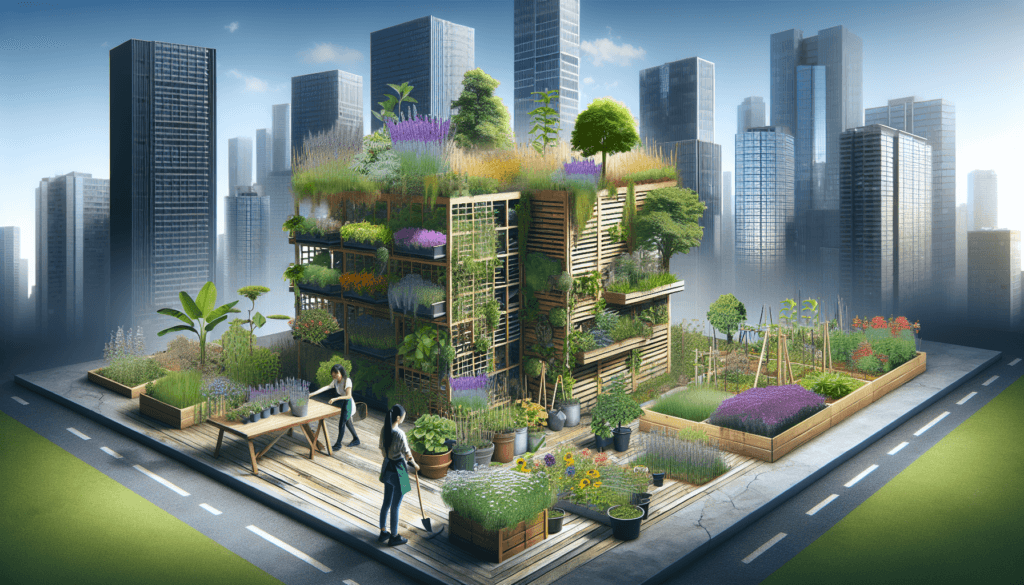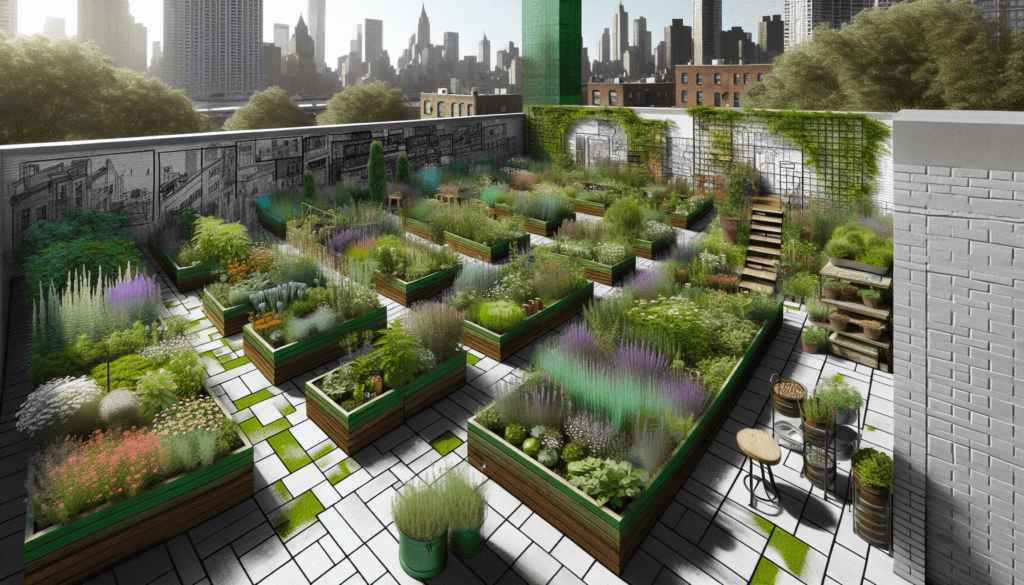So, you love gardening but have limited space in your urban jungle? Don’t worry, because in this article, we will show you how to bring the healing power of medicinal herbs into your urban garden! Whether you have a small balcony or a tiny backyard, there are plenty of creative ways to incorporate these plants into your urban oasis. From hanging baskets and vertical gardens to window boxes and raised beds, we will guide you through all the steps to create a thriving herbal haven right at your fingertips. So, get ready to unleash your green thumb and transform your urban space into a natural pharmacy!

Choosing the Right Medicinal Herbs
When it comes to creating your own urban medicinal herb garden, it’s important to begin by considering your health needs. Are you looking to grow herbs for general wellness, or do you have specific ailments you want to address? Understanding your health goals will help guide your selection of medicinal herbs.
Once you have a clear idea of your health needs, it’s time to research the properties and growing requirements of different herbs. Some herbs may require more sunlight, while others may prefer shade. Understanding the specific needs of each herb will help you determine which ones are best suited for your urban garden.
In urban environments, space can be limited, so it’s important to select herbs that thrive in such conditions. Look for herbs that are known to grow well in urban areas and are able to adapt to the potential challenges of city living. By choosing the right medicinal herbs, you’ll set yourself up for success in your urban garden.
Designing Your Urban Medicinal Herb Garden
Before you start planting your herbs, it’s important to assess the available space and light in your urban garden. Take note of how much sunlight each area receives throughout the day. This will help you determine where to place your herbs for optimal growth.
Creating a functional layout is key to maximizing the potential of your urban medicinal herb garden. Consider grouping herbs with similar needs together to make watering and maintenance easier. You may also want to plan for pathways or designated areas for different types of herbs. By carefully arranging your herbs, you can ensure easy access and a visually pleasing garden.
When planning your urban herb garden, it’s important to think about continual harvesting. Some herbs, like basil or mint, benefit from regular harvesting, as it encourages new growth. Leave enough space in your garden for ongoing harvesting, and consider planting in layers so you can harvest from different levels without disturbing the entire plant.
Preparing the Soil for Medicinal Herbs
A healthy, nutrient-rich soil is the foundation for a thriving herb garden. Before planting, it’s essential to test and amend the soil to create optimal growing conditions for your medicinal herbs. Testing your soil can help you identify any deficiencies or imbalances and allow you to amend accordingly.
Proper drainage is also crucial for the growth of medicinal herbs. Make sure your herb garden has well-draining soil to prevent waterlogging, as excess moisture can lead to root rot and other issues. If your soil has poor drainage, consider adding organic matter, such as compost or peat moss, to improve its structure.
When cultivating medicinal herbs in an urban environment, it’s important to avoid contaminants and chemicals. Urban areas may be exposed to pollution and toxic substances, which can negatively impact the health of your herbs. Choose organic soil amendments and avoid using chemical fertilizers or pesticides that could potentially harm your medicinal herbs.
Starting Seeds and Growing Seedlings
Starting your medicinal herbs from seeds or seedlings is a cost-effective way to establish your urban herb garden. When choosing seeds or seedlings, opt for high-quality varieties to ensure successful growth. Look for reputable sources and consider heirloom or organic options for a more sustainable garden.
To provide optimal germination conditions, follow the instructions on the seed packet or consult a gardening resource. Some herbs may require special treatment, such as soaking or scarification, to enhance germination. Creating a warm and moist environment will encourage the seeds to sprout and give your seedlings the best start in life.
When it’s time to transplant your seedlings into your urban garden, handle them with care. Gently loosen the roots and plant them at the appropriate depth, ensuring that the soil is firmly packed around the seedling. Water thoroughly after transplanting to help the seedlings establish themselves in their new home.

Caring for Medicinal Herbs in an Urban Garden
Proper watering and moisture management are essential for the health and vitality of medicinal herbs. While it’s important to keep your herbs adequately hydrated, overwatering can lead to root rot and other problems. Learn the specific moisture requirements of each herb and adjust your watering schedule accordingly.
Implementing organic pest control methods is crucial in an urban herb garden, as chemical pesticides can harm not only harmful pests but also beneficial insects and pollinators. Research natural alternatives for controlling common pests and diseases, such as companion planting or homemade insecticidal sprays. Regular monitoring and early intervention are key to preventing pest infestations.
Pruning and harvesting techniques play a vital role in the overall health and productivity of your medicinal herbs. Regular pruning helps maintain the shape of your plants and encourages new growth. Harvesting, on the other hand, allows you to reap the benefits of your herbs. Learn the proper techniques for pruning and harvesting each herb, as it can vary depending on the plant.
Utilizing Vertical Space for Herb Cultivation
In urban environments, vertical space is often underutilized. By employing hanging planters and trellises, you can maximize your herb cultivation potential. Hanging planters are ideal for herbs like trailing rosemary or thyme, while trellises provide support for climbing herbs like passionflower or hops.
If you have a balcony or windowsill in your urban garden, take advantage of the space by growing herbs in pots or containers. Many medicinal herbs thrive in these conditions and can provide beauty, fragrance, and functionality to your outdoor space. Hanging pots or window boxes are great options for urban gardeners with limited ground space.
For those with a bit more room, building vertical garden structures can add both functionality and aesthetics to your urban herb garden. Consider constructing a vertical herb wall using pallets or repurposed materials. This will allow you to grow an abundance of herbs in a small footprint, making the most of your available space.

Companion Planting for Medicinal Herbs
Companion planting is an effective way to enhance the growth and health of your medicinal herbs. By selecting beneficial companion plants, you can create symbiotic relationships that promote overall garden wellness. For example, planting marigolds alongside your medicinal herbs can deter harmful insects while attracting beneficial ones.
Certain combinations of companion plants can also repel pests naturally. For instance, planting garlic or chives near vulnerable herbs can help repel aphids and other common garden pests. Research the specific companion plants that work well with the medicinal herbs you have chosen and plan your garden accordingly.
Furthermore, companion plants can enhance the medicinal properties of your herbs. For example, planting calendula near chamomile can enhance the anti-inflammatory properties of both herbs. Experiment with different combinations and observe the results to discover the synergistic effects of companion planting in your urban herb garden.
Managing Containers and Small Spaces
Limited space is a common challenge in urban gardening, but with proper planning, you can overcome it. When choosing containers for your herbs, opt for ones that are appropriate for their size and have good drainage. Selecting lightweight containers made of materials like plastic or fabric can also make it easier to move them around.
Creating adaptations for limited space is essential in urban herb gardening. Consider vertical gardening techniques, such as tiered shelves or hanging baskets, to make the most of your available space. Additionally, using vertical space for trellises or wall-mounted planters can help free up valuable ground space for other herbs.
Implementing efficient irrigation systems is another key aspect of managing containers and small spaces. Drip irrigation or self-watering containers can help ensure your herbs receive consistent moisture while minimizing water waste. These systems also make it easier to care for your herbs, especially if you have a busy schedule or are frequently away from home.

Harvesting and Storing Medicinal Herbs
Understanding the optimal harvest times for your medicinal herbs is crucial to preserve their beneficial properties. Different herbs have different harvest windows, so it’s important to research and determine the best time to harvest each one. Harvesting too early or too late can affect the potency and flavor of your herbs.
After harvesting your medicinal herbs, it’s important to properly clean and dry them to prevent mold or degradation. Remove any debris or insects and gently rinse the herbs under running water. To dry the herbs, tie them into small bundles and hang them upside down in a cool, well-ventilated area.
To store your herbs for long-term use, choose airtight containers that are resistant to moisture and light. Mason jars or glass containers with tight-fitting lids are excellent options. Label your containers with the herb name and date of harvest to keep track of their freshness. Store your herbs in a cool, dry place away from direct sunlight to maintain their potency.
Addressing Potential Challenges in Urban Herb Gardening
Urban environments can present unique challenges for herb gardeners, but proactive measures can help overcome them. Air and noise pollution in cities can affect the health of your herbs, so it’s important to consider air quality when selecting herbs and to provide proper ventilation in your herb garden.
Contamination by urban chemicals is another concern when gardening in the city. Avoid using chemical fertilizers and pesticides and opt for organic alternatives instead. Regularly test your soil for contaminants and take appropriate measures to mitigate their impact on your herbs.
Urban wildlife, such as birds or squirrels, may be attracted to your herb garden. To protect your herbs, consider installing netting or bird scarers, or create physical barriers to deter wildlife from reaching your plants. Regularly inspect your garden for signs of pest damage and take immediate action to prevent further destruction.
In summary, incorporating medicinal herbs into your urban garden is a rewarding and sustainable way to promote wellness and self-sufficiency. By carefully selecting the right herbs, designing a functional layout, and providing proper care, you can create a thriving herb garden in the midst of the city. With a little patience and dedication, you’ll be enjoying the healing benefits of your own urban medicinal herb garden in no time.



